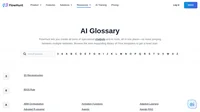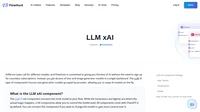What is ONNX?
Open Neural Network Exchange (ONNX) is an open-source format created to facilitate the interchangeability of machine learning models among various platforms and tools. Born out of a collaboration between Facebook and Microsoft, ONNX was officially launched in September 2017. It serves as a bridge across distinct machine learning frameworks, allowing developers to port models without restructuring or retraining them. This standardization fosters a more efficient and flexible approach to model deployment across different environments.
Key Features of ONNX
- Interoperability: ONNX is primarily designed to allow seamless model exchange between major machine learning frameworks such as TensorFlow, PyTorch, Caffe2, and Microsoft Cognitive Toolkit (CNTK). This interoperability extends to both deep learning and traditional machine learning models, enabling developers to leverage different tools’ strengths without being locked into a single ecosystem.
- Standardization: A unified format is provided by ONNX, which includes a common set of operators and data types. This standardization ensures models are consistent and functional when transferred across platforms, mitigating compatibility issues that often arise with proprietary formats.
- Community-Driven: The success and evolution of ONNX are largely attributed to its vibrant community of developers and organizations. This collaborative effort ensures that ONNX is regularly updated and improved, fostering innovation in AI model deployment.
- Hardware Optimization: ONNX supports multiple hardware platforms, offering model optimizations to enhance performance across various devices, including GPUs and CPUs. This capability is crucial for deploying models in resource-constrained environments or improving inference times in production systems.
- Versioning and Compatibility: ONNX maintains backward compatibility, allowing models developed with earlier versions to function effectively in newer environments. This approach ensures that models can evolve without sacrificing functionality or performance.
ONNX Runtime
The ONNX Runtime is a high-performance engine that executes ONNX models, ensuring efficient operation across diverse hardware and platforms. It provides multiple optimizations and supports various execution providers, making it indispensable for deploying AI models in production. ONNX Runtime can be integrated with models from frameworks like PyTorch, TensorFlow, and scikit-learn, among others. It applies graph optimizations and assigns subgraphs to hardware-specific accelerators, ensuring superior performance compared to original frameworks.
Use Cases and Examples
- Healthcare: In medical imaging, ONNX facilitates the deployment of deep learning models for tasks such as tumor detection in MRI scans across different diagnostic platforms.
- Automotive: ONNX plays a critical role in autonomous vehicles, enabling the integration of object detection models that support real-time decision-making in self-driving systems.
- Retail: ONNX streamlines the deployment of recommendation systems in e-commerce, enhancing personalized shopping experiences by utilizing models trained in different frameworks.
- Manufacturing: Predictive maintenance models can be developed in one framework and deployed in factory systems using ONNX, leading to improved operational efficiency.
- Finance: Fraud detection models created in one framework can be seamlessly integrated into banking systems using ONNX, bolstering fraud prevention measures.
- Agriculture: ONNX supports precision farming by enabling the integration of crop and soil models into various agricultural management systems.
- Education: Adaptive learning systems leverage ONNX to incorporate AI models that personalize learning experiences across diverse educational platforms.
Popular Frameworks Compatible with ONNX
- PyTorch: Known for its dynamic computational graph and ease of use, PyTorch is widely adopted in research and development.
- TensorFlow: A comprehensive framework developed by Google, offering APIs for building and deploying machine learning models.
- Microsoft Cognitive Toolkit (CNTK): Efficient for training deep learning models, notably in speech and image recognition tasks.
- Apache MXNet: Supported by Amazon, MXNet is recognized for its flexibility and efficiency across cloud and mobile platforms.
- Scikit-Learn: Popular for traditional machine learning algorithms, with ONNX conversion support via sklearn-onnx.
- Keras: A high-level API running on top of TensorFlow, focusing on fast experimentation.
- Apple Core ML: Enables model integration into iOS applications, with support for ONNX conversions.
Benefits of Using ONNX
- Framework Flexibility: ONNX allows switching between various machine learning frameworks, fostering flexibility in model development and deployment.
- Deployment Efficiency: Enables models to be deployed across different platforms and devices without significant modifications.
- Community and Industry Support: A robust community and industry backing ensure continuous improvements and widespread adoption of ONNX.
Challenges in Adopting ONNX
- Complexity in Conversion: The process of converting models to the ONNX format can be intricate, particularly for models featuring custom layers or operations.
- Version Compatibility: Ensuring compatibility between different versions of ONNX and frameworks can be challenging.
- Limited Support for Proprietary Operations: Some advanced operations may not be supported in ONNX, limiting its applicability in certain scenarios.
Understanding ONNX (Open Neural Network Exchange)
The Open Neural Network Exchange (ONNX) is an open-source format designed to facilitate the interchangeability of AI models across different machine learning frameworks. It has gained traction in the AI community for its ability to provide a unified and portable format for representing deep learning models, enabling seamless deployment across diverse platforms. Below are summaries of significant scientific papers related to ONNX, which highlight its application and development:
- Compiling ONNX Neural Network Models Using MLIR
Authors: Tian Jin, Gheorghe-Teodor Bercea, Tung D. Le, Tong Chen, Gong Su, Haruki Imai, Yasushi Negishi, Anh Leu, Kevin O’Brien, Kiyokuni Kawachiya, Alexandre E. Eichenberger
Summary: This paper discusses the onnx-mlir compiler, which converts ONNX models into executable code using the Multi-Level Intermediate Representation (MLIR) infrastructure. The authors introduce two new dialects within MLIR to optimize ONNX model inference. This work is pivotal in enhancing model portability and optimization across different computing environments. Read the full paper here. - Sionnx: Automatic Unit Test Generator for ONNX Conformance
Authors: Xinli Cai, Peng Zhou, Shuhan Ding, Guoyang Chen, Weifeng Zhang
Summary: The paper introduces Sionnx, a framework for generating unit tests to verify ONNX operator compliance across various implementations. By employing a high-level Operator Specification Language (OSL), Sionnx ensures comprehensive testing coverage, facilitating robust cross-framework verification. This tool is crucial for maintaining consistency and reliability in ONNX model execution. Read the full paper here. - QONNX: Representing Arbitrary-Precision Quantized Neural Networks
Authors: Alessandro Pappalardo, Yaman Umuroglu, Michaela Blott, Jovan Mitrevski, Ben Hawks, Nhan Tran, Vladimir Loncar, Sioni Summers, Hendrik Borras, Jules Muhizi, Matthew Trahms, Shih-Chieh Hsu, Scott Hauck, Javier Duarte
Summary: This paper extends the ONNX format to support arbitrary-precision quantized neural networks. The introduction of new operators such as Quant, BipolarQuant, and Trunc within the Quantized ONNX (QONNX) format allows for efficient representation of low-precision quantization. This advancement promotes more efficient neural network deployments on hardware with varying precision requirements. Read the full paper here.
OpenAI Review: Is It the Best AI Solution for You?
Explore OpenAI's advanced AI tools like ChatGPT for businesses, developers & more. Ethical, versatile & user-friendly solutions await you!"



